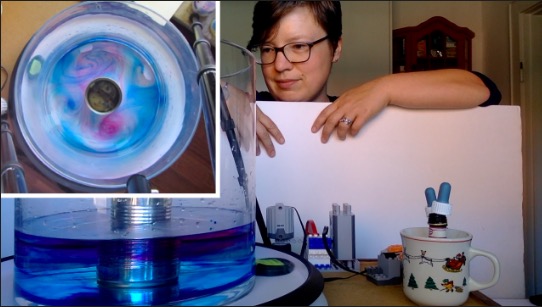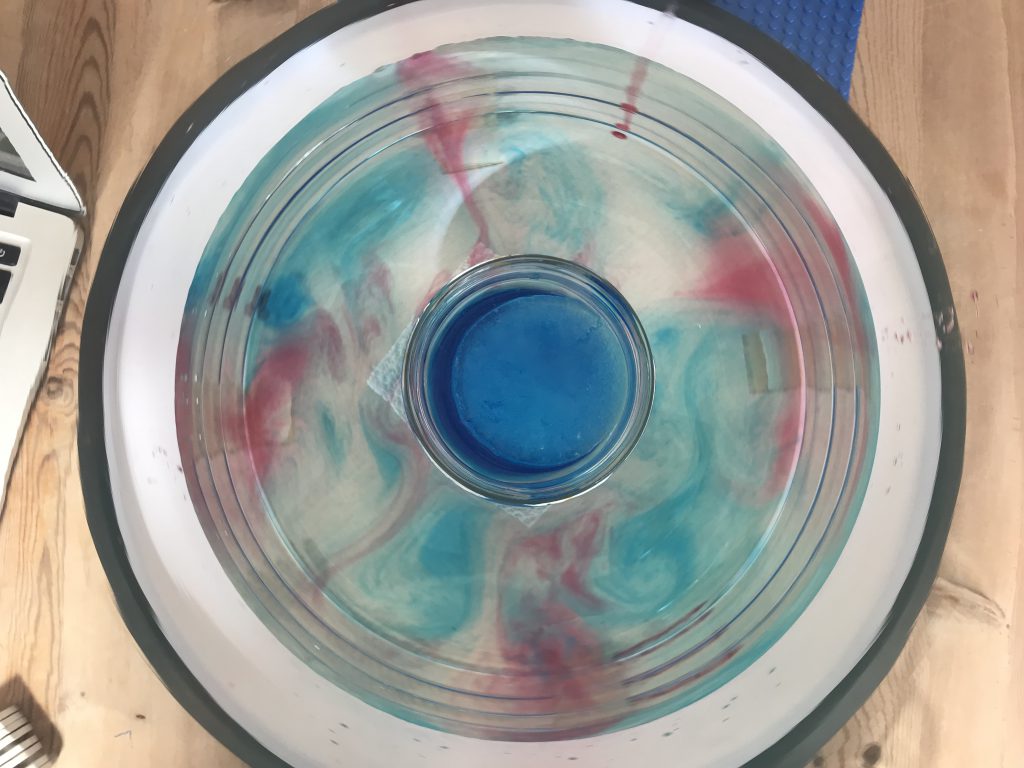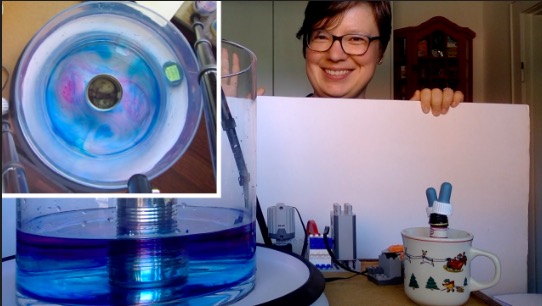
A common misconception in rotating tank experiments, and one way of maybe not reinforcing it
A very common misconception when looking at atmosphere & ocean dynamics in a rotating tank is that the center of the tank represents one of the poles and the edge of the tank the equator. And there is one experiment that — I fear — might reinforce that misconception, and that is the one we love to show for rotation vs thermal forcing, baroclinic instabilities (fast
rotation), Hadley cell circulation (slow rotation).
When we do this experiment, the tank looks like a polar stereographic view of the Earth, with the pole (represented by the blue ice in the picture below) in the center and the equator at the edge of the tank. And when we then talk about the eddies we see as representing weather pattern, it’s all too easy to assume that the Coriolis parameter also varies throughout the tank similarly as it would on Earth, only projected down into the tank. Which is not the case!

But the good news is that it’s super easy to drive this experiment by heating rather than cooling in the center of the tank. The physics are exactly the same, only the heat transport is now happening radially outward rather than radially inward. And that it’s now not the easiest assumption any more that we are looking down at the pole.
Also: Heating in the middle is a lot easier to do spontaneously than cooling using ice — no overnight stay in the fridge required, just a kettle! :-)

What are other misconceptions related to rotating tanks that you commonly come across? And do you have any advice on how to prevent these misconceptions or elicit, confront, resolve them?
Throwback to the pandemic and teaching from home: "An ocean in a bucket" - Adventures in Oceanography and Teaching says:
[…] This is a very common misconception, especially in cylindrical tanks, and it is also easily reinforced by the way we commonly set up experiments. But it is still […]
"Wonder questions" and geoscience misconceptions. - Adventures in Oceanography and Teaching says:
[…] I’m familiar with misconceptions in physics (especially the ones related to hydrostatics and rotating systems & Coriolis force that I’ve worked with), and within iEarth there has been a lot of talk […]
Barry Klinger says:
Your post gave me another interesting idea: how about doing the annulus experiment with the annulus *not centered on the center of the turntable*? I think there is a deeper misconception students have which is that your dynamics in a rotating frame depends on where you are relative to the center of rotation. This is a pretty resonable belief, and *is* true for the centrifugal force, which GFDers ignore because its neutralized by the bowl-shaped surface of the water.
By reversing the temperature gradient, you are vividly showing that the pole-to-equator analogy breaks down, but you probably aren’t addressing the “where are we relative to the spin axis?” misconception. By going off-center (like maybe having the whole annulus on one side of the turntable center, if possible), student has to deal with that.
Now one problem with my suggestion is that it might actually *matter* that the annulus is off-center. If the tank has a flat bottom, then the tilt of the water surface due to the centrifugal force will create a gradient in the thickness of the water which could have dynamical effects. The direction of the gradient will be different depending on where the annulus is placed.
PS How are you dealing with experiments in the age of coronavirus?
Mirjam says:
Hi Barry, Great to “hear” from you again! Hope you are doing well in these crazy times! :)
We’ve actually tried moving the heating/cooling to the edge of the tank and it works fine in terms of the physics (we aren’t rotating quickly enough for the slope of the surface to become important). It’s just that it’s actually a lot more difficult to observe features in that experiment without a co-rotating camera. One gets quite dizzy! Somehow it seems to be a lot easier to observe features that are arranged symmetrically around the axis of rotation. But thanks to the DIYnamics team, I might be able to simulate a co-rotating camera soon, so stay tuned :-)
And it’s definitely a great suggestion to think more in that direction, I completely agree with your comment that students believe that it matters where they are relative to the center of rotation. I’m probably guilty of reinforcing that just by wanting my experiments to look pretty…
Due to Corona, we are doing “virtual” experiments right now: https://mirjamglessmer.com/remotely-controlled-diynamics-kitchen-oceanography-experiments/
It’s working surprisingly well, more student interaction than I had anticipated/feared ;-) Also, if you are interested to remotely play with my rotating tank to test these things, I’d be more than happy to virtually invite you into my kitchen! :-)